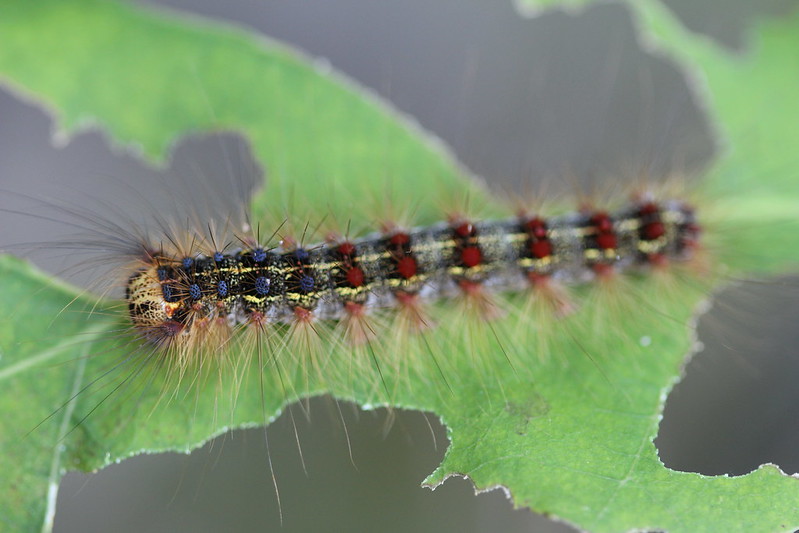The skies were blue, but the gentle sound of pattering rain filled the forest where we were camping. This wasn’t the usual watery rain, but a steady rain of tiny bits of leaves and caterpillar poop raining down from the trees above. Caterpillar poop is known as frass, and I was happy that I packed the canopy to go over the picnic table so that I wouldn’t be eating frassy food.
The ground at the campground was covered in scraps of leaves and frass, all courtesy of an outbreak of Gypsy Moths. These European moths were introduced to North America in the 1860’s, when a Massachusetts man raised them with hopes of using their cocoons to make silk. This didn’t work, but the moths escaped and soon began munching away on the forests of Massachusetts. Now, over 150 years later, they have spread throughout northeastern North America.

Gypsy Moths go through boom and bust cycles. In some years, they are hardly noticeable. In others, they rain down upon the world from the trees above in a caterpillapocolypse. They are more gross than destructive. Many trees will lose all their leaves to the caterpillars’ incredible appetites, but few will die from the loss.
Outbreaks happen every ten years or so. The last one was in 2012, when I couldn’t set a cup of coffee down without 10 caterpillars crawling onto it in seconds. Tree leaves were eaten to the point that trees were reduced to leafless skeletons. This gives me some reassurance, since the oaks and maples that completely lost their leaves back then are still alive and thriving.
I have been trying to switch my mindset about these outbreaks. It is easy to look at the devastation, the defoliation, the sheer massive scale of destruction, and panic. It’s easy to dwell on how these caterpillars from another continent destroy the forests that I love and adore. It’s harder to put that destruction into a broader, less gut-wrenching perspective.
After all, what is the big impact? Most of the trees will recover. Perhaps there will be a skinny ring inside them to show this was a year of poor growth due to the insect outbreak. Perhaps they will outcompete other caterpillars for the same food this year. The leaves and caterpillar poop that hit the forest floor will create a nutrient rich layer that helps new trees and wildflowers flourish.
It is easy to look at the destruction wrought and feel horror at the scale of destruction caused by an invasive insect pest. It is harder to step back and look at it from a larger perspective. This once-a-decade event might only happen a dozen or so times in the life of a tree, which will be recorded as thin rings inside the tree showing a year with poor growth. Since this doesn’t happen each year, the tree has a decade to recover before the next incident.
A lot can happen in those years between. Researchers have been diligently trying to figure out where these outbreaks come from and have come up with some amazing sources. Nature works like clockwork, with each bit causing something to happen in each other bit, but we know so little that nature might as well be an invisible clock that must be worked on with invisible tools. While there are people who can identify much of the plants and animals out there, there is little knowledge of how it all interacts. Gypsy Moth outbreaks are the exception that proves how little we know. Gypsy Moth outbreaks seem to be caused by acorns.
It’s weird, since Gypsy Moths don’t eat acorns. Mice, however, do. Every few years, oak trees have huge numbers of acorns in what is called ‘masting’. This huge harvest of acorns means that lots of mice store up extra food and have extra babies. These mice and their babies also eat Gypsy Moth eggs in the winter. However, tons of mice starve to death after the oak masting event, since there are way more mice than available food. Two years after the huge acorn harvest, the mouse populations crash and few mice are around to eat the Gypsy Moth eggs. The Gypsy Moth population then explodes and eats all the leaves in the forest.

Long term, scientists worry that the forest will start to look like a buffet after everyone has gone through. The only things left are the things few eat, like cinnamon-covered-Kale. If you think of the forest as a Gypsy Moth buffet, scientists are worried that the oaks and hickories that are beloved by the Gypsy Moth caterpillar will decline and the less preferred foods will flourish.
The truth is, as much as we already know, the Environmental Impact Statement for Gypsy moths is full of the word “may” and “could”, scientific words that mean “I don’t know, but I think . . .. “ Gypsy Moths have been here for over 150 years, but we still don’t know everything there is to know about them.
Expect many trees to lose their leaves this summer. Expect to stand under a rain of caterpillar poop in the forest. Expect poor-growing timber for the next couple of years, which “may” be accompanied by increased berry growth in the understory of the forest.
Think of the Gypsy Moth outbreak as a short-term grossness to tolerate that will go away next year or the year after. The life of a forest is long, and these outbreaks are often mere blips in the life of the trees.
Audubon Community Nature Center builds and nurtures connections between people and nature. ACNC is located just east of Route 62 between Warren and Jamestown. The trails are still open from dawn to dusk as is Liberty, the Bald Eagle. The Nature Center is partially open, including restrooms, the Blue Heron Gift Shop, and some exhibits. More information can be found online at auduboncnc.org or by calling (716) 569-2345.


Recent Comments